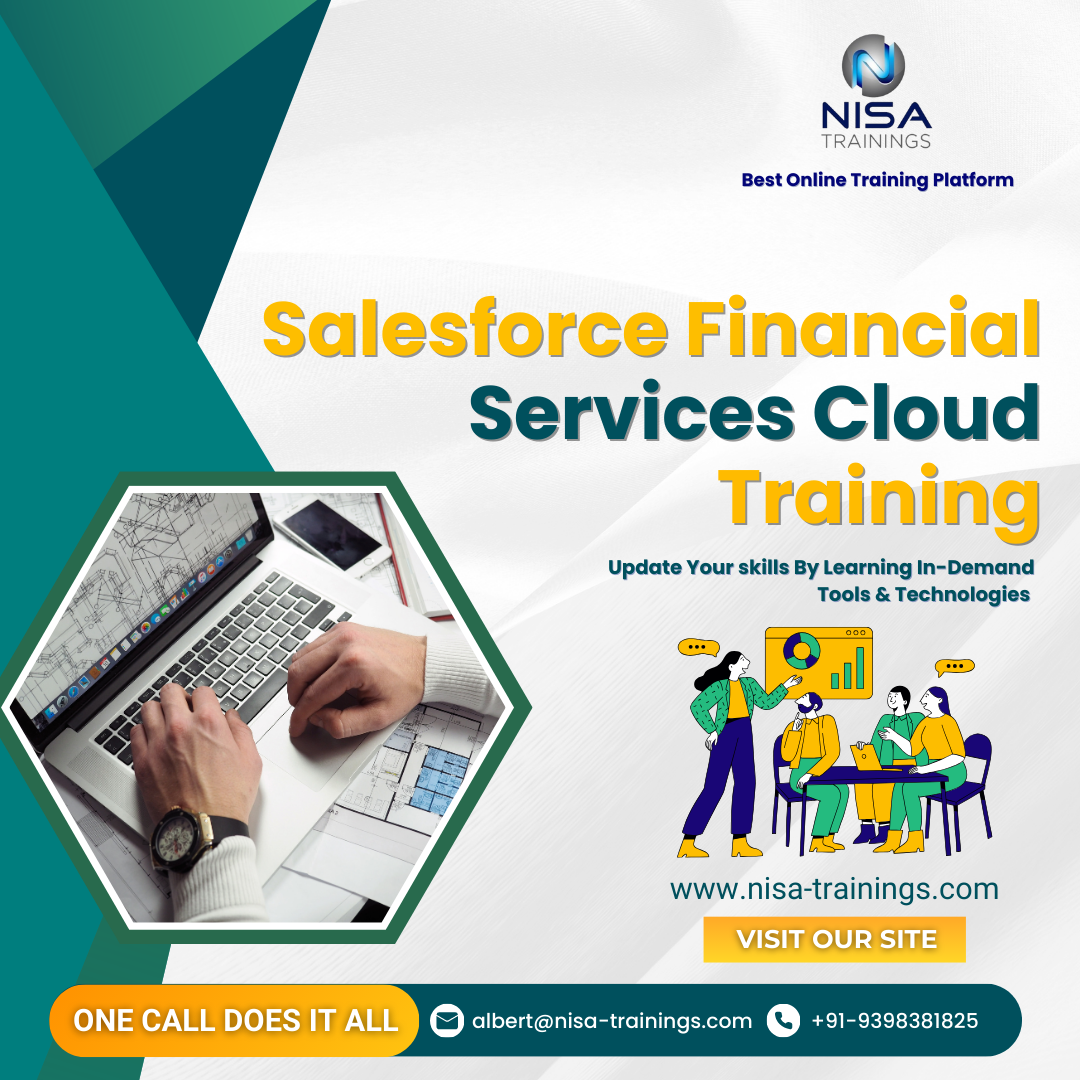Salesforce Financial Services Cloud Training
Salesforce Financial Services Cloud (FSC) is a specialized version of Salesforce CRM designed to meet the unique needs of financial services organizations, including wealth management, banking, insurance, and other financial sectors. It provides financial advisors, relationship managers, and other financial professionals with a comprehensive suite of tools to manage client relationships, financial accounts, and industry-specific processes.

Why should you choose Nisa For Salesforce Financial Services Cloud Training?
Nisa Trainings is the best online training platform for conducting one-on-one interactive live sessions with a 1:1 student-teacher ratio. You can gain hands-on experience by working on near-real-time projects under the guidance of our experienced faculty. We support you even after the completion of the course and happy to clarify your doubts anytime. Our teaching style at Nisa Trainings is entirely hands-on. You’ll have access to our desktop screen and will be actively conducting hands-on labs on your desktop.
Job Assistance
If you face any problem while working on Salesforce Financial Services Cloud Course, then Nisa Trainings is simply a Call/Text/Email away to assist you. We offer Online Job Support for professionals to assist them and to solve their problems in real-time.
The Process we follow for our Online Job Support Service:
- We receive your inquiry for Online Job
- We will arrange a telephone call with our consultant to grasp your complete requirement and the tools you’re
- If our consultant is 100% confident in taking up your requirement and when you are also comfortable with our consultant, we will only agree to provide service. And then you have to make the payment to get the service from
- We will fix the timing for Online Job Support as mutually agreed by you and our consultant.
Course Information
Salesforce Financial Services Cloud Training
Duration: 25 Hours
Timings: Weekdays (1-2 Hours per day) [OR] Weekends (2-3 Hours per day)
Training Method: Instructor Led Online One-on-One Live Interactive
Sessions.
COURSE CONTENT :
1. Introduction to Salesforce Financial Services Cloud
- Overview of Financial Services Cloud (FSC)
- Introduction to Salesforce’s tailored solutions for financial services organizations (wealth management, banking, insurance).
- Key features and benefits of FSC.
- Comparing FSC with the core Salesforce CRM.
- FSC Industry Use Cases
- Wealth management, banking, insurance, and more.
- Understanding how FSC addresses industry-specific needs and processes.
2. Salesforce Financial Services Cloud Data Model
- Financial Account Data Model
- Overview of the financial account, including relationships between clients, households, and financial accounts.
- Setting up financial accounts (e.g., investments, policies, and liabilities).
- Client and Household Management
- Working with clients and households.
- Linking clients to their household and managing family/household structures.
- Opportunities and Relationships
- Managing opportunities for clients, financial goals, and lifecycle management.
- Overview of relationship management tools (e.g., relationship maps).
3. Configuring Salesforce Financial Services Cloud
- Customizing Financial Services Cloud
- Custom fields, page layouts, and record types for financial services.
- Creating and customizing Financial Services Cloud objects.
- Understanding different data types and customizing Financial Account records.
- Financial Account Types
- Configuring and managing different types of financial accounts (banking, wealth management, insurance).
- FSC Features and Tools
- Financial Services Cloud console, home page, and record pages.
- Task management for advisors and client interactions.
- Using financial planning tools (e.g., goals and financial health assessments).
4. Client and Household Management
- Managing Clients
- Creating, viewing, and updating client profiles.
- Client segmentation, tracking interactions, and relationship mapping.
- Household Management
- Managing households and family members in FSC.
- Linking multiple clients together and tracking family financial goals.
5. Financial Planning and Case Management
- Financial Goal Management
- Setting and tracking financial goals for clients.
- Creating and updating financial plans.
- Case Management
- Managing and tracking client service requests and cases.
- Using case management tools for handling client issues, such as claims or account adjustments.
6. Reports and Dashboards
- Standard FSC Reports
- Financial account performance reports.
- Client relationship management reports.
- Custom Reports and Dashboards
- Creating custom reports and dashboards to track client portfolios and financial goals.
- Building reports for financial advisors and client managers.
- Visualization Tools
- Visualizing client data and financial health using Salesforce reports and charts.
7. Automation in Financial Services Cloud
- Workflow and Process Automation
- Automating common processes using Process Builder, Flow Builder, and Workflow Rules.
- Automating financial planning activities and reminders for advisors.
- Service Automation
- Automating service requests and client communications.
8. Integration with External Systems
- Integration Basics
- Connecting Financial Services Cloud with external financial tools and data sources.
- Understanding APIs, connectors, and third-party integrations for financial data.
- Data Import and Export
- Importing data into FSC (e.g., financial transactions, client information).
- Exporting data for reporting, analysis, or integration with other systems.
9. Financial Services Cloud Security and Compliance
- Security Best Practices
- Ensuring data security for financial data.
- Managing permissions, profiles, and roles in FSC.
- Compliance Management
- Ensuring adherence to financial industry regulations (e.g., GDPR, PCI DSS).
- Using Salesforce’s built-in compliance tools and auditing features.
10. Client Engagement and Communication
- Omnichannel Communication Tools
- Using Salesforce to communicate with clients through email, phone, or social media.
- Personalizing client communication based on financial goals and preferences.
- Advisory Services
- Managing client meetings, planning sessions, and reports for financial advisors.

